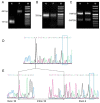Aberrant Splicing in GJB1 and the Relevance of 5' UTR in CMTX1 Pathogenesis
- PMID: 33375465
- PMCID: PMC7824018
- DOI: 10.3390/brainsci11010024
Aberrant Splicing in GJB1 and the Relevance of 5' UTR in CMTX1 Pathogenesis
Abstract
The second most common form of Charcot-Marie-Tooth disease (CMT) follows an X-linked dominant inheritance pattern (CMTX1), referring to mutations in the gap junction protein beta 1 gene (GJB1) that affect connexin 32 protein (Cx32) and its ability to form gap junctions in the myelin sheath of peripheral nerves. Despite the advances of next-generation sequencing (NGS), attention has only recently also focused on noncoding regions. We describe two unrelated families with a c.-17+1G>T transversion in the 5' untranslated region (UTR) of GJB1 that cosegregates with typical features of CMTX1. As suggested by in silico analysis, the mutation affects the regulatory sequence that controls the proper splicing of the intron in the corresponding mRNA. The retention of the intron is also associated with reduced levels of the transcript and the loss of immunofluorescent staining for Cx32 in the nerve biopsy, thus supporting the hypothesis of mRNA instability as a pathogenic mechanism in these families. Therefore, our report corroborates the role of 5' UTR of GJB1 in the pathogenesis of CMTX1 and emphasizes the need to include this region in routine GJB1 screening, as well as in NGS panels.
Keywords: 5′ UTR; CMT; Charcot-Marie-Tooth; Connexin 32; GJB1; X-linked Charcot-Marie-Tooth (CMTX1); noncoding; splicing.
Conflict of interest statement
The authors declare no conflict of interest.
Figures




References
-
- Murphy S.M., Laura M., Fawcett K., Pandraud A., Liu Y.T., Davidson G.L., Rossor A.M., Polke J.M., Castleman V., Manji H., et al. Charcot-Marie-Tooth disease: Frequency of genetic subtypes and guidelines for genetic testing. J. Neurol. Neurosurg. Psychiatry. 2012;83:706–710. doi: 10.1136/jnnp-2012-302451. - DOI - PMC - PubMed
-
- Fridman V., Bundy B., Reilly M.M., Pareyson D., Bacon C., Burns J., Day J., Feely S., Finkel R.S., Grider T., et al. CMT subtypes and disease burden in patients enrolled in the Inherited Neuropathies Consortium natural history study: A cross-sectional analysis. J. Neurol. Neurosurg. Psychiatry. 2015;86:873–878. doi: 10.1136/jnnp-2014-308826. - DOI - PMC - PubMed
-
- Cortese A., Wilcox J.E., Polke J.M., Poh R., Skorupinska M., Rossor A.M., Laura M., Tomaselli P.J., Houlden H., Shy M.E., et al. Targeted next-generation sequencing panels in the diagnosis of Charcot-Marie-Tooth disease. Neurology. 2020;94:e51–e61. doi: 10.1212/WNL.0000000000008672. - DOI - PMC - PubMed
LinkOut - more resources
Full Text Sources
Research Materials
Miscellaneous

